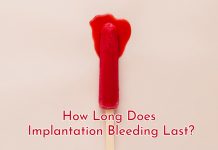Most of us want to find out about early signs of pregnancy. Implantation is the first stage of development of the fetus. Most people don’t know about implantation. Basal body temperature(BBT) is an indicator of ovulation. However, it is rarely discussed when detection of pregnancy is our concern.
What is implantation?
- Implantation is the attachment of the baby’s first cells to the inner wall of the uterus (womb).
- It takes place after the fertilized egg has traveled from the Fallopian tube to the uterus.
- Pregnancy Tests detect hCG hormone in urine. This hormone forms in body only after implantation.
- Some women might experience erratic bleeding during this process called ‘implantation bleeding.‘ Cramps and abdominal pain is common during implantation bleeding.
What is basal body temperature?
- Basal body temperature (BBT) is the lowest temperature attained by the body during a day.
- It is the temperature attained when we are relaxed, and all metabolic processes are running at the basal pace.
- It is the reason why it is advisable to record BBT just after waking up. Preferably without getting out of your bed.
Factors affecting basal body temperature:
- Any form of physical activity or mental stress
- Physiological illness like fever, cough, and cold
- Hormonal pills or supplements
- Consumption of drugs or alcohol
- Erratic sleep
- Nursing a newborn – breastfeeding
How to chart (Record) basal body temperature?
Recording basal body temperature doesn’t need any elaborate procedure or instruments. Your regular thermometer will suffice. All you have to do:
- Keep your thermometer handy for recording the BBT.
- After waking up, place the thermometer in an appropriate place and record the body temperature.
- Prepare a chart with dates written and jot down the BBT you just checked.

Are basal body temperature (BBT) and implantation related?
There is a lot of ambiguity surrounding the topic ‘Relation of BBT and implantation.’ It is still under research.
- The rise of BBT after few days of ovulation overlaps the initial stage of implantation. It is only a logical interpretation of BBT and implantation.
- It is the ½ – 1° F rise or ¼ – ½ ° C rise of BBT post ovulation. People mistake it for BBT rise after implantation.
- Symptoms of implantation and rise of BBT assure implantation. Cramping, implantation bleeding, etc. are symptoms of implantation.
- It happens after a week from expected ovulation date.
Can Basal body temperature indicate Implantation?
No. One cannot be sure about implantation by analyzing BBT changes. You might see patterns and those patterns may be just coincidences.
There is no scientific ground to support the fact that the BBT rises during implantation.
Basal body temperature and Ovulation?
- Basal body temperature and ovulation are very closely related. BBT rises just before ovulation very slightly.
- On the ovulation day it can rise to extra ½ – 1° F or ¼ – ½ ° C.
- In the luteal phase (post-ovulatory) the basal body temperature falls for a day. The onset of periods generally accompanies this.
- After this, the BBT comes back to normal.
Basal body temperature and Cervical Mucous
Observing changes in basal body temperature and cervical mucus can help predict ovulation date.
Cervical mucus and BBT have a pattern during ovulation stage of menstrual cycle.
During your most fertile days, you’ll notice a white color mucus and an increased Basal body temperature.
What is an implantation dip?
An implantation dip is the fall of basal body temperature by one-degree post one week from ovulation.
Implantation tends to occur after a week from ovulation. It is the time for the drop in BBT. Thus it gets the name ‘implantation dip.‘
Though there is no validation, implantation dip is more common in pregnancy.
BBT charts of pregnant women have prominent implantation dip. Implantation dip is also seen in nonpregnant females but rarely.
What are the causes of implantation dip in basal body temperature?
The causes of implantation dip remain elusive. Only one reason for implantation dip is satisfactory, and that is the surge of estrogen.
Estrogen peaks twice during a menstrual cycle. It rises once before ovulation and once after ovulation.
The second rising of estrogen is responsible for implantation dip.
Does implantation dip indicate pregnancy?
No. Implantation dip and pregnancy might appear to have a relation. But it is merely overlapping or proximal timing of body changes.
What is a reliable basal body temperature indicator of implantation?
A triphasic basal body temperature chart along with a longer luteal phase indicates implantation.
A triphasic basal body temperature chart means
a) Stage 1 – Rise of BBT during ovulation,
b) Stage 2 – Implantation dip,
c) Stage 3 – BBT restoring to normal range
The post-ovulatory phase of menstrual cycle called luteal phase generally lasts for a 12 – 13 days period. If this exceeds by a day, then you are undergoing implantation.
One crucial thing to mention here is that we only discuss the various possibilities here.
We hardly know anything about you. So as an individual, you may be experiencing something entirely different, and that could be normal.
Before jumping to conclusions, a doctor considers a combination of signs and symptoms.
Hence, it is important that you seek medical assistance if you experience any doubtful changes in your body.





![Implantation Bleeding With Twins [How long does IB last with twins?] Implantation Bleeding With Twins](https://www.pregnanteve.com/wp-content/uploads/2019/01/implantation-bleeding-with-twins-218x150.jpg)




